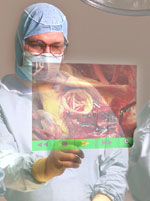Article
Holographic controls may be wave of the future
HoloTouch Inc. president R. Douglas McPheters has invented a control interface that floats in mid-air and responds to human touch. The new technology may get its start in the operating room.
December 11, 2002
R. Douglas McPheters is venturing boldly where no man has gone before with his new kiosk interface known as HoloTouch.
McPheters, president of HoloTouch Inc., invented a system that uses holograms in place of keypads, touchscreens or buttons to control electronic devices such as cell phones, TVs and kiosks.
"As a person stands in front of the kiosk the image is floating 6 to 8 inches from the projector," McPheters said. "When you put your finger on a specific area on the hologram an infra-red beam sends a signal. It's like the same way your keyboard would send a signal to your computer."
An infrared emitter points at the area of the hologram and tells the kiosk which letter or number was pushed.
The actual hardware for the system is a sealed box containing a light source, the infrared beam and a plastic 5-by-5 inch plate bearing the image to be projected as a hologram, such as a keypad or other navigational tools.
"All you've got is an infrared beam behind a piece of plastic so there are no moving parts to replace," McPheters said. "It's very durable."
McPheters uses HoloTouch with Power Point during his demonstrations. The holographic keypad removes the need for the computer's keyboard or a remote device to navigate the program.
 |
R. Douglas McPheters |
McPheters, a Yale graduate and a former chief engineer of a submarine for the U.S. Atlantic Fleet, secured a patent for his interface design last spring.
Still, the new technology isn't in use yet, except in McPheters' demonstrations.
"We're working with four different companies right now, although I can't name them," McPheters said. "In a way, this is so beyond new. You wouldn't believe the folks that are interested in it."
Folks such as the U.S. military. HoloTouch may one day replace touchscreens in fighter jets.
"When you get up into high altitudes, the sun puts a glare back into the pilot's face," McPheters said. "With this there is no glare."
Before founding Connecticut-based HoloTouch Inc., McPheters was chief operating officer of two high-tech startups, Medigenesis and Commercexchange, in the medical information and publishing sectors and practiced law in Manhattan with Shearman & Sterling and his own firm for 25 years. In his practice, he specialized in corporate securities and merger and acquisition transactions.
Standard operating procedure
Initially, the new technology is bound for the operating room, where a sterile environment is a matter of life or death.
McPheters demonstrated the equipment for heart surgeons at NYU on Dec. 9, and said the technology was well received.
HoloTouch would reduce the amount of time spent sterilizing equipment.
 |
HoloTouch |
Because the hologram cannot be contaminated or contaminate anything else, McPheters believes it's ideal for operating rooms.
Freeport, N.Y.-based VTS, a medical equipment manufacturer, plans to adapt McPheters' system for use with its operating room control units within two months, said Allan Katz, a biomedical engineer and president of VTS.
VTS makes touchscreen controls for the operating room that are centrally located for easy access, Katz said. The touchscreens allow the staff to control the sound system, climate controls, and equipment settings among other things.
Katz attended McPheter's demonstration at NYU.
"We're really interested in this," Katz said. "Right now (doctors) have to rely on an attending nurse to adjust the controls."
Katz said doctors often use high-temperature cautery knives to make incisions during operations. The tool requires multiple adjustments, changes which a doctor must instruct a nurse to carry out via a touchscreen.
"With this the doctor could do it himself, and she could be doing the other things she needs to do," Katz said.
Since doctors often record surgeries for future reference, HoloTouch would allow them to move back and forth through the footage quickly without the aid of a nurse.
Katz hopes to have a working prototype in the next four weeks, but getting it into the operating room may take longer.
"We have to get FDA approval for this," Katz said.
The sky is the limit
Although McPheters is focused on medical uses right now, he can think of limitless uses for the interface.
"My dream consumer application is that the controls for your TV are projected next to your easy chair or bed so all you do is lean over and put your finger in a hologram version of your remote," McPheters said.
Other uses could be for ATMs or other machines that accept personal identification numbers (PIN).
"For kiosks, when you make holograms, you can be fairly specific on what angle it can be viewed," McPheters said. "You can use a narrow field to increase security for PIN numbers."
Dr. John Perry of Holographics North Inc., the creator of McPheters' holographic plate, agreed. The company is located in Burlington, Vt.
"Most of them (holograms) are viewable from a 55 degree horizontal angle (from about 2 feet away), if you go further than that the hologram disappears," Perry said. "The field can be narrowed. It can be so narrow that you couldn't even see it with both eyes."
Perry said with a narrow field, the person next to you would not be able to see which numbers you punched.
Money matters
Since Holotouch's control panels work with existing software and effectively replace keyboards or touchscreens, its cost is relatively low, especially if mass-produced, McPheters said.
"The pieces of this are really bare bones," McPheters said. "When you put it together for a specific application the price will vary."
The pieces include the cost of the artwork and master slide production, a light source (McPheters uses a halogen lamp in his demo model) and the laser sensor.
McPheters said he put together his demo model for about $100.
"These are small enough, 10 to 12 inches or smaller, that they can be mass-produced," Perry said. "A 5-by-5-inch image can be produced for 50 cents to $1 a piece."
Perry said the cost of the image master, from which the small plates are made, could range from $1,000 to $6,000 depending on the amount of artwork involved.
"We could put a logo behind or in front of it (a keypad) that could be three dimensional or it could be animated, Perry said. "The animation happens when you walk by."
The company's Web site displays many examples of 3D images and logos made for other clients, including one for the Chrysler Corp. that features a large, bronze color wire frame globe with continents that fade as a viewer walks by. As the continents fade, the Chrysler logo and slogan, "Great Cars, Great Trucks," zooms forward.
Holographic advertisements may be an option as well.
"For example, a kiosk in an airport that operates a telephone could have an advertisement in the hologram that says, `If you turn around you can see Starbucks; go and get a hot cup of coffee," McPheters laughed.






